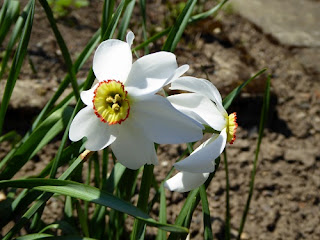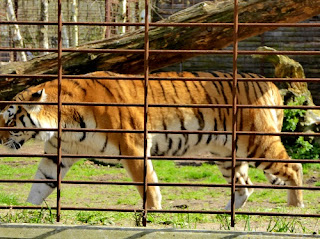The bars give the game away: the four tigers I saw were mostly lying down or on their backs enjoying a perfect spring day in their enclosure at Odense Zoo - lucky riverside walkers that these were the beasts we got to see for free.
I love this civilized and easy-going city with the feel of a small town. Went there for the first time last June
the day after Carl Nielsen's 150th birthday (the link is to the second page of a report on The Arts Desk) and enjoyed the museum and childhood-home visits perhaps more than the Vienna Philharmonic's very skewed view of the Fourth, 'Inextinguishable' Symphony in the concert hall. This time we were on terra firma with the admirable Odense Symphony Orchestra supporting the three finalists of the Carl Nielsen International Violin Competition (there are also competitions for flute and clarinet, the other solo instruments for whom Nielsen wrote concertos). Something about that in my
Arts Desk interview with the refreshingly honest and direct Nikolaj Znaider. A good start on my way to the interview, passing the Andersen statue near the concert hall
was a blackbird singing very loudly directly above.
I've been lucky in my recent trips to Tallinn, Odense and most recently beloved Gottingen in that the days have been mostly free for me to play the tourist. Having spent time in the Hans Christian Andersen and Nielsen Museums, this time I wanted to pursue the river beyond the city boundaries, but I couldn't help revisiting the splendid cathedral, and caught several other churches en route. First stop, nearest to the hotel and the concert hall, St Hans, closed after the morning service.
Friday was a day of national prayer, so the shops were shut, the Danish flags were flying and young and old alike were sunning themselves in the parks on a perfect spring day. After the hour and a half with Znaider, I made my way past the handsome collection of old houses that makes up Møntergården, the museum of the city's cultural history, with its assemblage of old buildings,
and then past an earlier Andersen childhood home
and the street which slopes down beneath it
hoping to make it as far as another model village further,
Den Fynske Landsby, along the river - that would have made a nice complement to the
pre-Christmas walk in Swedish Örebro. I didn't get that far, probably spending too much time going back to the very pleasing Cathedral of St Canute.
Canute/Knud IV, that same Dane who legendarily wanted to halt the tide on an English beach, was murdered in Odense, along with his brother, in the savage uprising of 1086; his bones were interred first at St Alban's Priory where he had been slain - the church was rebuilt in the 19th century but I think this building next door may be older -
and then in the first cathedral. That burned down in 1247 and the pleasant building of red-brick Gothic was planned in 1300 but not consecrated until nearly 200 years later; the tower dates from even later, 1586.
The inside is so pleasing in its calm white simplicity, reminding me
of those marvellous Saenredam paintings of Dutch church interiors.
It's
essentially simple, but much enriched by Claus Berg's magnificent
altarpiece of 1515-25, moved here from the demolished Franciscan priory
church in 1807.
How did it survive the Reformation?
Probably owing to its association with the four royals whose bodies were
also transferred here at that time. Hans of Denmark and Christina of
Saxony have an especially fine tombstone also including their son, and likewise Berg's work.
Apart from the crypt, with its bones of Canute
and his brother, treasures and archaeological remains of the first church, there's also a grand chapel to the Ahlefeldts, which an otherwise rather sneery Marryat - according to Sacheverell Sitwell - described as 'a really noble dormitorium', guarded by Time with scythe
and some 'great coffins like travelling chests, covered with gold repousse work' - the one with crucified Christ on the lid, lying rather ruinously, adds more atmosphere.
But it was time to leave thoughts of mortality behind
and join life on the lawns below Abbey Hill
with careful star-shapes of daffodils on the lawns
and a route through to the river
which passed lawns of relaxing students on one side
Odense's main theatre, currently showing a highly-praised production of Lars von Trier's
Dogville and with an interesting operatic repertoire including Mascagni's
L'amico Fritz. founded in 1796 and Denmark's second oldest - a mural celebrates some of its characters (real life stage management beneath):
Leaving behind the folk in pedallos, you pass the gardens of elaborate villas with rather special huts at the bottom
and then come the tigers, mostly lazing in the first warm sun of the year
though this one did stir to lope along to another resting place, so much less distressing than the psychotic pacing one sees from many tigers in such small enclosed spaces.
The river bifurcates Odense Zoo, just as Regent's Canal does London's - this version even has a mini Snowdon aviary on the 'other' side.
Clearly I was running out of time to get to the assemblage of old Funen houses, so I crossed at the point - curses - where the scenery becomes truly rustic and walked back on the other side through the woods where 19th century Danes used to disembark for rural picnics
and alongside the main entrance to the zoo
and more pleasant green riverbank
to the town, where I regretted not having enough time to go round Brandts, an old textile mill converted into a major art exhibition space
but did manage time enough to go inside the Gråbrødre Klosterkirke
, which as I understand it is the replacement for the old Greyfriars where the Berg altarpiece used to be displayed.
It seems to be a sort of beguinage like the lovely one in Amsterdam. Refreshments were laid out for the evening service
and a blissful choir of three were rehearsing in the chapel. Pleasing, if not very old, I'm assuming. Note the hanging ship.
And so back via Andersenville
to the hotel to freshen up for the final of the Carl Nielsen Competition.
























































































